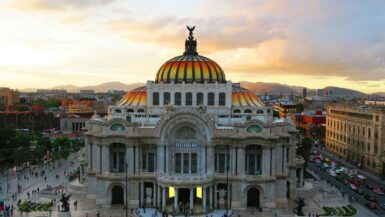Sumidero Canyon is a natural wonder located in the southern Mexican state of Chiapas, just north of the state’s capital city, Tuxtla Gutiérrez. The deep canyon, which is over a kilometer deep, was formed by the erosion of the Grijalva River.
The canyon is a popular tourist destination, known for its stunning views and diverse wildlife.

The canyon is home to a variety of flora and fauna, including jaguars, crocodiles, and spider monkeys.
Visitors can take a boat tour of the canyon, which provides an up-close look at the towering cliffs and waterfalls.
The canyon is also an important cultural site, with several ancient Mayan ruins located in the surrounding area.
Key Takeaways
- Sumidero Canyon is a natural wonder located in the southern Mexican state of Chiapas, just north of the state’s capital city, Tuxtla Gutiérrez.
- The canyon is a popular tourist destination, known for its stunning views and diverse wildlife.
- Visitors can take a boat tour of the canyon, which provides an up-close look at the towering cliffs and waterfalls.
Geography and Formation

Geological Features
Sumidero Canyon is a natural wonder located in the southern Mexican state of Chiapas, just north of the state’s capital city, Tuxtla Gutiérrez. The canyon was formed by cracks in the Earth’s crust along with erosion by the Grijalva River, which still flows through it.
The process of its formation began about 35 million years ago, making the Sumidero contemporary with the Grand Canyon on the Colorado River.
Canyon Walls
The canyon walls rise vertically up to 1,000 meters above the river and exhibit numerous small caves, rock formations, and waterfalls.
The walls are made up of limestone, sandstone, and shale, and are home to a variety of plant and animal species, including crocodiles and monkeys.
Grijalva River
The Grijalva River runs through the Sumidero Canyon, cutting spectacular walls that are a sight to behold.
The river is the fourth largest in Mexico and is also known for its hydroelectric power generation capabilities.
It is fed by several tributaries, including the Santo Domingo and the La Angostura.
Overall, the Sumidero Canyon is a breathtaking natural wonder that attracts visitors from all over the world. Its geological features, canyon walls, and the Grijalva River make it a must-visit destination for anyone traveling to Chiapas, Mexico.
Biodiversity and Ecology

Flora and Fauna
Sumidero Canyon is a natural wonder that boasts a diverse range of flora and fauna. The canyon walls are covered in lush vegetation, providing a habitat for a variety of animals.
The park is home to over 500 species of birds, including toucans, eagles, and the elusive quetzal.
Additionally, the canyon is home to several species of mammals, including jaguars, ocelots, and spider monkeys.
The waters of Sumidero Canyon are also teeming with life.
The Grijalva River that flows through the canyon is home to several species of fish, including the Mexican tetra.
The river is also home to the American crocodile and the Central American river turtle.
Conservation Efforts
Sumidero Canyon is a UNESCO Biosphere Reserve, and as such, it is protected by the Mexican government. The park is also home to several conservation efforts aimed at preserving the canyon’s unique ecosystem.
One such effort is the conservation of the American crocodile population.
In the 1970s, the crocodile population was threatened due to hunting and habitat destruction. However, the Mexican government implemented a conservation program that has helped to stabilize the population.
Another conservation effort is the protection of the spider monkey population.
The spider monkey is an endangered species, and the park is home to one of the largest populations in Mexico.
The Mexican government has implemented several programs aimed at protecting the spider monkey, including habitat restoration and anti-poaching measures.
Overall, the conservation efforts in Sumidero Canyon are a testament to the Mexican government’s commitment to preserving the country’s natural wonders.
Tourism and Activities

Boat Tours
One of the most popular activities to do in Sumidero Canyon is taking a boat tour. Visitors can enjoy a scenic ride through the canyon while admiring the towering cliffs and stunning waterfalls.
These boat tours are usually conducted by experienced guides who provide interesting information about the canyon’s history and wildlife.
For the boat ride, it’s recommended to bring sunscreen and wear comfortable clothing.
Viewpoints and Hiking
For those who prefer a more active experience, there are several viewpoints and hiking trails in Sumidero Canyon.
Visitors can hike to the top of the canyon and enjoy panoramic views of the surrounding landscape.
The “Christmas Tree” is a popular viewpoint that offers incredible views of the canyon and surrounding mountains.
There are also several miradores (viewpoints) located throughout the canyon that offer stunning vistas.
Cultural Significance
Sumidero Canyon has great cultural significance to the indigenous people of Chiapas. The canyon was considered a sacred site by the ancient Maya and was used for religious ceremonies.
Today, the canyon is protected as an ecological park and is an important site for scientific research and conservation efforts.
Visitors can learn about the canyon’s cultural and ecological significance at the park’s visitor center.
Overall, there are plenty of activities to do in Sumidero Canyon, from boat tours to hiking and cultural exploration. It’s recommended to book a Sumidero Canyon tour in advance to ensure availability and to make the most out of your visit.
Conservation and Challenges

Environmental Protection
Sumidero Canyon is a protected natural monument, and it is also a National Park managed by the National Commission of Natural Protected Areas (CONANP).
The park is home to a diverse range of flora and fauna, including several endangered species.
To protect the environment, the park has several regulations in place, such as prohibiting littering, hunting, and fishing.
The ecological park has implemented several conservation programs, such as reforestation and habitat restoration, to maintain the biodiversity of the area.
The park also has a waste management program to minimize the impact of human activities on the environment.
Visitors are required to follow the park’s guidelines to ensure the protection of the natural resources.
Human Impact
Despite the park’s efforts to protect the environment, human activities have significantly impacted the area. The park’s popularity as a tourist destination has led to an increase in pollution and trash.
The park management has implemented several measures to address this issue. These include installing trash cans and organizing cleanup campaigns.
The construction of a reservoir upstream of the canyon has also affected the environment. The reservoir has reduced the water flow in the canyon and has changed the ecosystem.
The park management is working with the government to address this issue and minimize the impact on the environment.
In conclusion, Sumidero Canyon is a unique natural wonder that requires ongoing conservation efforts to maintain its beauty and biodiversity. The park management and visitors must work together to protect the environment and minimize the impact of human activities on the area.





